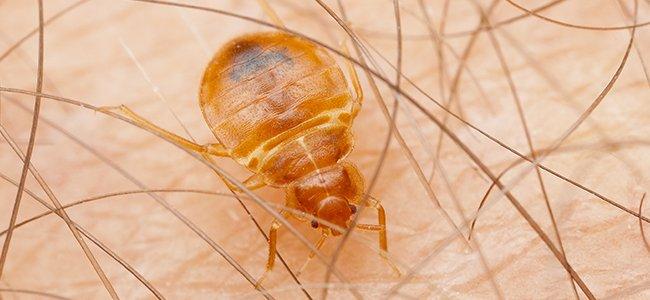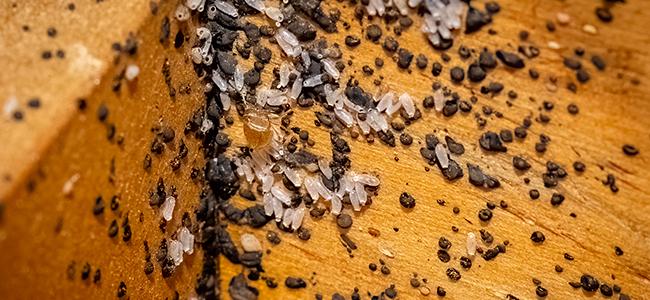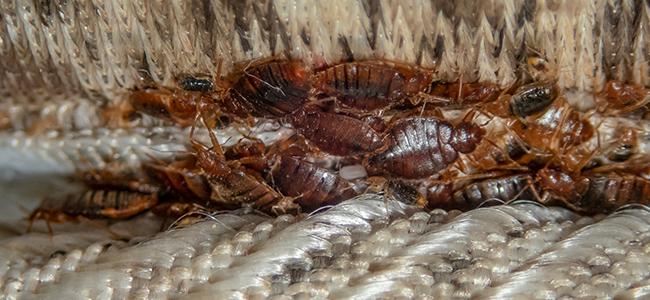
Fact vs. Myths: Bed Bugs In Washington D.C.
01/20/2022
Bed bugs are small parasitic pests that often resemble an apple seed to the naked eye. They have a wingless, oval-shaped body with a reddish-brown ...
READ MORE >
07/20/2020

Although having pests anywhere in your house is an unpleasant thought, there’s something especially disturbing about the idea of pests being in your bed. Just the fact that there is a pest with the word “bed” in its name is enough to make you want to check your sheets before climbing into them each night.
Bed bugs are a big problem in homes and businesses all over the United States. If your Washington D.C. home has been experiencing a bed bug problem, you have to take action to eliminate it because it won’t go away on its own. Many homeowners are tempted to attempt do-it-yourself bed bug control methods, but these are almost always a waste of money. Read on to find out why and to learn what you should do instead.
Bed bugs are small parasitic bugs, which means they require a host to live. While humans are their preferred host, bed bugs can also survive on the blood of other mammals like cats, dogs, rodents, and bats.
Bed bugs are small, apple seed-sized pests that are reddish-brown in color as adults. They are smaller and a creamy white color as nymphs, which can make them difficult to see if you’re not carefully looking for them.
Female bed bugs can lay up to five eggs a day, making it easy for a small bed bug infestation to become a large one rather quickly.
Bed bugs were nearly eradicated in the US in the late 1950s and barely heard about except in a popular nursery rhyme through the 1990s. However, they have made a startling comeback over the past couple of decades, and they are now alive and well all over the United States. In fact, any home or business, from the most rundown house to the ritziest hotel, is at risk of a bed bug infestation.
The reason no home or business is immune from a bed bug infestation is due to the way that bed bugs get into buildings. Unlike most pests that find their way into your yard, then into your home from your yard, bed bugs operate differently.
Bed bugs enjoy traveling and will hitch a ride on whatever they find passing by. That may be your pant leg or shoe, a bag they crawl into before you pick it up to carry it home, or the luggage you use when you stay in a bed bug-infested hotel room.
At some point along your journey, they’ll crawl off or out of the item they hitched a ride on. This may be in a public place, such as in a library or on public transportation, it may be in another hotel, or it may be in your home.
Although they’re called bed bugs, these tiny insects are just as happy to hide in locations other than beds. You can find them in the seams of upholstered furniture, behind picture frames on the wall, in cracks and crevices in the flooring or on walls, and even inside electrical sockets. While mattresses may be bed bug's preferred location due to their close proximity to sleeping hosts, their adaptability to various types of buildings is one of the reasons they’ve made such a big comeback in recent years.
There are several signs to look for when you suspect a bed bug infestation in your home. Most homeowners first suspect bed bugs when they start waking up with red bumps on their bodies. If you’ve started noticing bug bites you didn’t go to bed with, you should look for these signs to determine if you have a bed bug infestation:
Red, itchy bites
Tiny red spots of blood on your sheets or blankets.
Small tan or brown streaks on your sheets or blankets.
Bed bugs themselves in the seams of your mattress, between your mattress and box spring, between your mattress and headboard, behind picture frames, in cracks and crevices, and in the seams of upholstered furniture.
Bed bug casings or eggs in any of the above-mentioned places.
If you find any of the signs mentioned above in your house, you likely have a bed bug infestation. This leads to the obvious question of what you should do about them. Letting them be is not an option since they will grow and grow in population until they overrun your house. One thing many homeowners decide to do is try to get rid of them on their own.
There are several reasons that Washington D.C. homeowners try to get rid of bed bugs on their own, but the most common reason is because they think professional bed bug control is too expensive. If you call a pest control company for a bed bug control quote, it can seem pricey, so your next thought might be that you can take care of the bed bugs and save money by using a do-it-yourself form of bed bug control.
Other reasons for trying to get rid of bed bugs on your own might include not wanting the hassle of other people coming into your house, wanting to only use all-natural methods, or wanting to be in full control of the process.
If you do an internet search, you’ll find all kinds of DIY bed bug treatments that will supposedly solve your bed bug problems. Many people want to use natural methods that are safe for their family, so they try things like vinegar or baking soda, which are both touted online as effective bed bug treatment options.
Another common do-it-yourself method of bed bug control is using bed bug sprays. These sprays can be found at any general big box or hardware store for a few dollars. That makes them seem like a great and cost-effective solution.
It’s also common for people attempting to eliminate a bed bug problem on their own to try washing and drying all of their bedding and clothing. They may also vacuum their carpets, and even their mattresses, to try to eliminate the infestation.
Vinegar does kill bed bugs when they come in direct contact with it. However, unless you are prepared to spend inordinate amounts of time and vinegar, spraying areas of your house, and attempting to spray the bed bugs themselves, you are unlikely to remove the whole problem.
Baking soda is one of those DIY treatment methods that has no scientific backing and simply does not work. You can sprinkle it around your house, but you will still have bed bugs crawling around.
Bed bug sprays can be effective at eliminating bed bugs, but they have a couple of disadvantages. First, applying them safely can be tricky. You must carefully follow the instructions listed on the bottle to keep the area safe for your family members. Second, bed bug sprays are the type of treatment that usually only eliminates part of the problem. Bed bugs that are hidden away in your walls, as well as eggs, will remain alive and well.
Finally, there is the DIY method of bed bug control that involves washing bedding and clothing and vacuuming floors. Although this is an important part of bed bug control (even when you hire a professional), it won’t take care of the problem on its own. Bed bugs will remain in your mattress and other areas of your home and will be eager to come out to feed on you after you change your sheets.
As you may have guessed from the title of the article, do-it-yourself methods of bed bug control are rarely, if ever, effective. They might reduce the number of bed bugs you have in your house for a short period of time, but unless you eliminate every single bed bug in your house, including the nymphs and eggs, you will not get rid of your infestation. It will simply return after a few weeks.
While you attempt these DIY methods, you waste precious time and money that would be better spent on proven solutions. Although it’s tempting to try to save money and hassle by doing it yourself, in the end, DIY bed bug control leads to wasting money and increasing the hassle as your bed bug infestation continues to grow. You’ll end up spending money on treatments that don’t work, then spending more money hiring the professional you were trying to avoid.
At American Pest, we understand that having a bed bug infestation is stressful and a serious cause for concern for Washington D.C. homeowners. With nearly 100 years of experience treating pest problems, we are well-equipped to swiftly eliminate your bed bug problem.
Because we understand that you may have budget constraints or desire an all-natural treatment option, we offer several types of bed bug control methods to meet your needs. In addition to conventional liquid treatments, we also offer thermal remediation (heat treatments) and K9 inspections.
Our K9 inspections utilize specially-trained bed bug detecting dogs. These dogs can pinpoint bed bug activity with an incredible degree of accuracy, which helps ensure we get the best results with our treatments.
Conventional liquid treatments are ideal for smaller infestations and infestations that haven’t spread throughout the house. They typically require two to three treatments and/or follow-up visits to ensure full eradication.
Our heat treatments do not require the use of any chemicals and usually eliminate every bed bug in every stage of development in just one treatment. Heat treatments are ideal for large, widespread infestations.
When you contact American Pest, we’ll listen to your concerns and work with you to develop a bed bug control plan that works for your particular situation, needs, and budget. Don’t waste money on solutions that don’t work.
Start with the pros and get the job done right the first time. Contact American Pest today.

01/20/2022
Bed bugs are small parasitic pests that often resemble an apple seed to the naked eye. They have a wingless, oval-shaped body with a reddish-brown ...
READ MORE >

12/03/2021
Bed bugs can be difficult to identify, but this guide is here to help you tell them apart from other pests in Washington D.C. Read on to get the ma...
READ MORE >

11/15/2021
Bed bugs may be small, but they can often cause major problems once they infest your Maryland home. Contact the professionals a...
READ MORE >

10/30/2021
Bed bugs can appear in almost any residential environment, from communal living to busy family homes. Contrary to popular belief, bed bugs do not c...
READ MORE >

Protect your home and family from nuisance and potentially damaging pests with a Preferred Care home pest control plan. Starting at $49/month

Don't let the bed bugs bite a second longer. Contact American Pest for the most comprehensive bed bug control in the industry. Learn More

Our certified rodent control pros will put an end to your frustration by getting rid of rats and mice inside your home. Learn More

Say goodbye to wood-destroying termites in your home when you contact American Pest for expert termite control. Learn More

Trust American Pest to deliver professional backyard tick control services that are guaranteed to get results. Learn More

Don't spend the warm-weather season indoors, find out how American Pest's professional treatments get rid of mosquitoes. Learn More
Fill out the form and recieve feedback in less than 5 minutes. For immediate service please call.